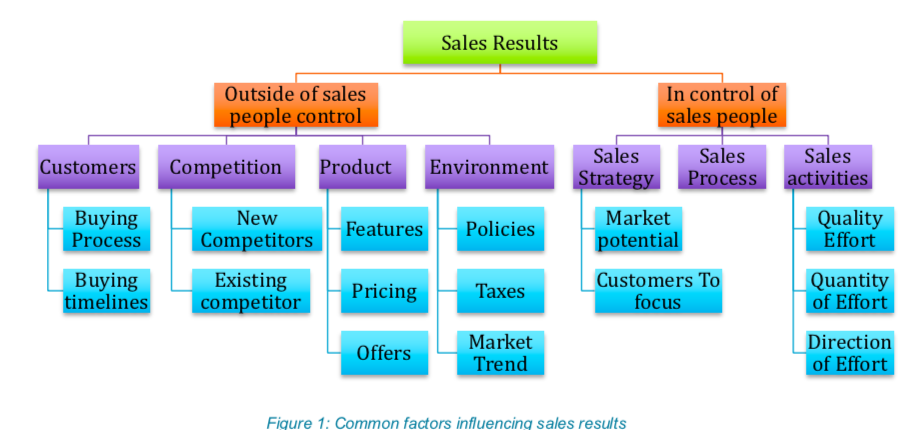When it comes to sales training initiative, measuring the success of sales training or ROI in terms of business results is not clear. This inhibits many businesses to take up sales training initiatives.
Many companies we meet ask this question about sales training. Since I am investing money on this training, how do I clearly measure the impact with respect to business results such as sales revenue growth, profit margins, new accounts generated etc?
Indeed measuring ROI in terms of business results must be considered, but focusing only on business results is a wrong way to see the initiative!
In this article, we will address how to measure sales training success.
So, before we answer how to measure sales training success in an organization, let’s dig further on some more misconceptions many companies have about sales
3 reasons why companies don’t see the need for sales training
Firstly, as can be seen from the below figure, sales results is indeed a function of many macros as well as micro factors. The salesforce has a role to play in bringing sales results but it is not everything. In many businesses, sales professional roles are limited to just order taking!
Sales training mostly focus on improving sales process, sales force effectinvess and it is a small part overall sales function and it rarely gets budgeted.

Secondly, even in companies where sales professionals play the key role in sales (selling complex solutions, difficult buying environments) sales training initiatives require a culture where learning must be a key value driver of the company. The leaders must value professional development and individual growth.
But if the company has a culture of emphasis on short term revenue generation, the sales training initiatives will be questioned as
- What is there to learn?
- Our sales are great as long as business conditions are good
- I lose money every day I take my sales staff out of the field
Lastly, Sales training related activity though easiest and cost-effective to increase sales productivity, the lack of understanding on measuring returns on sales training investments compared to many other initiatives stops most businesses to go for sales training.
Measuring the sales training returns
In the book, The Complete Guide to Accelerating Sales Force Performance by Andreas Zoltners & Prabhakar Sinha, they explain the ways to measure the sales training effectiveness using 4 types of measures as below,
| Ways to Measure | What to Measure | How to Measure | When to Measure |
| Cognitive Effect- “What do learners know?” | Knowledge of course content | Exams, Self-Assessment,Interview | At the completion of training and at points in the future |
| Attitudinal Effect – “How do learners feel?” | Perceptions of training. Course Evaluation Instructor Evaluation, Organisation Climate | Survey Interview | At the completion of the training |
| Behavioural Effect – “What do learners do?” | Skills, Job Performance, Absenteeism, Turnover, Measuring Sales Process Metrics | Performance Indicators Observation, Managerial Assessment, Self-Assessment, CRM Data | Over the first year |
| Results – “How do learners changes affect the organisation?” | Job Satisfaction, Customer Satisfaction, Sales, Profits, ROI | Survey, Experiments, Managerial Judgement | After a year |
Depending on the type of sales training conducted the best way to measure sales training success is to measure the non-finance related returns in the short term and finance related returns over the long term.
With CRM, Sales Enablement technologies, it is now far easier to measure the before and after changes due to sales training. All one needs is to capture the metrics related to
Conclusion
Instead of sales training activity being seen as any other sales activity, it must be seen as explained by the authors of the book, “Accelerating Sales Force Performance”
Sales training exists to make salespeople successful -continuously successful
From the book Sales Force Performance – Zoltners & Sinha
The markets are continuously changing and the skill, attitude gap keeps widening b/w what market wants vs. what sales professionals possess and training is one of the fastest ways to fill this gap.
Most organization indeed provide training to the sales force at the time hiring as there is a significant capability gap exists. But the changing market environment continuously induces the capability gaps in the existing sales force staff.
For ex, the earlier way of prospecting no more works in today world. Today buyers have lot more information advantage than what used to be decade back. Social selling is becoming a norm now.
So, the forward looking organisations are continuously adapting with new selling strategy, sales process and addressing capability gaps in sales force.
Lack of a mechanism to measure business results due to training should not inhibit from going for training as the successful sales training initiatives are going reflect in results over time.
At the same we do believe, sales training is not a solution for all sales related problems. But if companies believe success in sales is due to successful sales professionals then, sales training is the best initiative
